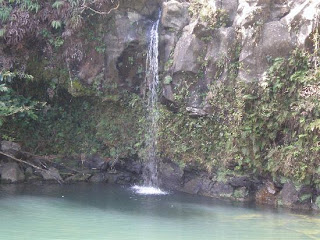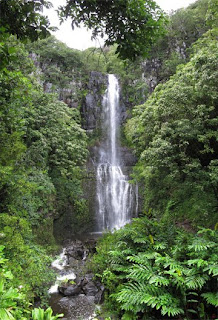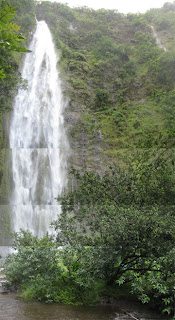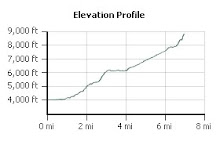We drove on until reaching Pua'a Ka'a State Wayside Park, around mile marker 22. This park was actually more promising for a real hike. After viewing the lower falls, our guide book said that if we climbed up a short trail on the other side of the river, we would find another, more beautiful waterfall.
 That trail had, since the book's printing, obviously washed out. You could see where the pavement ended rather abruptly into mud. We started climbing what initially looked like a dirt trail, however, it became clear about halfway up that we were actually in the creek bed. While climbing, one of my feet came out of its shoe. Fortunately, I managed to put it back in the shoe before stepping in the mud. We all got very muddy here, nevertheless. At the top of this small hill, we reached a dirt road.
That trail had, since the book's printing, obviously washed out. You could see where the pavement ended rather abruptly into mud. We started climbing what initially looked like a dirt trail, however, it became clear about halfway up that we were actually in the creek bed. While climbing, one of my feet came out of its shoe. Fortunately, I managed to put it back in the shoe before stepping in the mud. We all got very muddy here, nevertheless. At the top of this small hill, we reached a dirt road. We continued down the dirt road to the left and, almost immediately, came to a small, steel footbridge over an aqueduct. This area gets most of the rainfall on the island and is prime watershed. A series of pipes carry water from this part of the island to the rest of the island. This small footbridge was the most difficult portion of our hike, and somewhat dangerous, but we all made it over. We resumed the very muddy trail on up the hill and a short time later arrived at Upper Pua'a Ka'a Falls.
We continued down the dirt road to the left and, almost immediately, came to a small, steel footbridge over an aqueduct. This area gets most of the rainfall on the island and is prime watershed. A series of pipes carry water from this part of the island to the rest of the island. This small footbridge was the most difficult portion of our hike, and somewhat dangerous, but we all made it over. We resumed the very muddy trail on up the hill and a short time later arrived at Upper Pua'a Ka'a Falls.On the way back down, we decided to follow the dirt road to see if there was another way down to the road, instead of taking the same muddy way back. This dirt road apparently belongs to the East Maui Irrigation company, so we figured they must have a way down. Shortly past the turn off to the muddy way we had come up, we found a nice - dry - dirt road that took us almost directly back down to the road. If only we had known on the way up, we could have avoided the mudding that we all got!
Our next stop was at Kahanu Garden, a short drive just off the Hana Highway at mile marker 31. Kahanu Garden has the world's greatest collection of breadfruit, and more beautiful flowers, but this isn't its main attraction. The centerpiece of Kahanu Garden is the Piʻilanihale Heiau, the remains of the largest ancient temple in the Hawaiian Islands. It was begun in the 14th century, about the same time that the great cathedrals of Europe were being completed, and was finished in the 16th century by Chief Pi'ilani after he unified the island of Maui. This massive temple is built on top of a lava flow out of basalt and takes up about 3 acres. It's hard to grasp the immensity of this building from the ground. Fortunately, aerial photos of the temple give us a better idea of its scope.

 After about 45 minutes of walking through the gardens and seeing the ancient temple and many beautiful wildflowers, we continued on to Hana, reaching it a short time later. It was about 1:00 pm and we decided that it was time to stop for lunch. Hana is a fairly small town and there isn't a great selection of restaurants. We had lunch at the Hana Ranch Restaurant. The food was fine, though it took over an hour to arrive and didn't come as ordered. That said, the bathrooms were a welcome respite and gave us the opportunity to wash off some of the mud we had been accumulating over the course of the day. After lunch, we went down to the black sand beach and walked around a bit, while the kiddo played and tried to catch more sand crabs. We considered walking to a red sand beach just around the point from the beach, but the trail was washed out, making the way impassable for all but mountain goats. This was, however, much more of a delay than we had planned for in Hana and we needed to move on.
After about 45 minutes of walking through the gardens and seeing the ancient temple and many beautiful wildflowers, we continued on to Hana, reaching it a short time later. It was about 1:00 pm and we decided that it was time to stop for lunch. Hana is a fairly small town and there isn't a great selection of restaurants. We had lunch at the Hana Ranch Restaurant. The food was fine, though it took over an hour to arrive and didn't come as ordered. That said, the bathrooms were a welcome respite and gave us the opportunity to wash off some of the mud we had been accumulating over the course of the day. After lunch, we went down to the black sand beach and walked around a bit, while the kiddo played and tried to catch more sand crabs. We considered walking to a red sand beach just around the point from the beach, but the trail was washed out, making the way impassable for all but mountain goats. This was, however, much more of a delay than we had planned for in Hana and we needed to move on. After lunch, we continued on past Hana, reaching the last waterfall - Wailua Falls, near mile marker 45 - that we would see before our final destination. This is a truly great waterfall, descending almost 200 feet off a lava precipice, with a beautiful view from the road. Fortunately, there was a parking lot at this stop, as well as several vendors selling their wares to the many passersby. We didn't stay long. We still hadn't reached our final destination - the Ohe'o Gulch - and it was already 2:30 pm.
After lunch, we continued on past Hana, reaching the last waterfall - Wailua Falls, near mile marker 45 - that we would see before our final destination. This is a truly great waterfall, descending almost 200 feet off a lava precipice, with a beautiful view from the road. Fortunately, there was a parking lot at this stop, as well as several vendors selling their wares to the many passersby. We didn't stay long. We still hadn't reached our final destination - the Ohe'o Gulch - and it was already 2:30 pm.Our plan was to finish up the day with a proper hike up the Pipiwai Trail to see Ohe'o Gulch, also known as the "Seven Sacred Pools". The name was an invention for tourists, there aren't seven pools and they aren't sacred. Nevertheless, it's one of the most spectacular hikes on the island. If you're going to go all the way out to Hana, you need to go a little further because this is a must see. By the time we reached the portion of Haleakala National Park that contains the Ohe'o Gulch, it was already 3:00 pm. The Pipiwai Trail being only 4 miles round trip, we decided we still had enough time to do the hike and make it back to the car before dark. We put on our hiking gear and off we went.
There is no diving allowed in the pools off the Pipiwai Trail. People have tried this in the past, with sometimes fatal results, not just from the submerged rocks that can't be seen from above, but also from flash floods originating from rain farther up the mountain. Swimming is still allowed, but only when there hasn't been such rain that flash floods are possible. Signage to this effect is posted at the entrance to the park at the Kipahulu Ranger Station. Because it had been raining today, albeit lightly, we kept to the main trail after taking in the tremendous view.
At this point, the trail became quite muddy but since we were still pretty muddy from our earlier adventures, this didn't really bother us. What's a few more layers of mud? We slogged on until we reached another waterfall, difficult to see, but what could be seen was a good view of the eroded lava tube into which it flowed.
After the bridges, we entered a bamboo forest. This was by far the most fascinating part of the hike. Daylight receded far behind us as we moved into the forest. The bamboo rose so high - at least 20 feet above us - that it blocked out most of the light, so much that we almost needed flashlights. The bamboo was so dense here that, if there wasn't already a trail, you wouldn't be able to get through without several sharp machetes. Here too, the path was so muddy that the trail was actually a platform made out of Trex planks. We continued this way for the last 0.7 miles until we came back to the Ohe'o stream
At this point, we could hear the roar of a waterfall getting louder and louder. We knew we were getting close, but we couldn't tell quite how close. The last section of the trail required us to fjord a shallow, but swift, stream. We walked very carefully through the stream until, a minute or two later, we came to another stream. This one was more difficult to cross, but all of the hikers there helped each other which made it much easier.
 At this point, it was raining pretty heavily, or at least that's what we thought until we realized that this wasn't rain, but the waterfall coming down on top of us. We looked up and there was Waimoku Falls, our final destination on this hike, towering above us. This time, instead of looking down on the Falls from above, we were looking almost straight up out of the lava tube. It was an incredible sight! We stayed for several minutes to take it all in, and then hurried back down the trail, so that we would get to our car before dark. This we did, and then the long drive home, back the way we had come.
At this point, it was raining pretty heavily, or at least that's what we thought until we realized that this wasn't rain, but the waterfall coming down on top of us. We looked up and there was Waimoku Falls, our final destination on this hike, towering above us. This time, instead of looking down on the Falls from above, we were looking almost straight up out of the lava tube. It was an incredible sight! We stayed for several minutes to take it all in, and then hurried back down the trail, so that we would get to our car before dark. This we did, and then the long drive home, back the way we had come. I drove most of the way back on the mostly unlit Hana highway, grateful for the fact that I was following another car's red taillights to show me the way. We were very muddy, and by this time hungry, but very happy.



